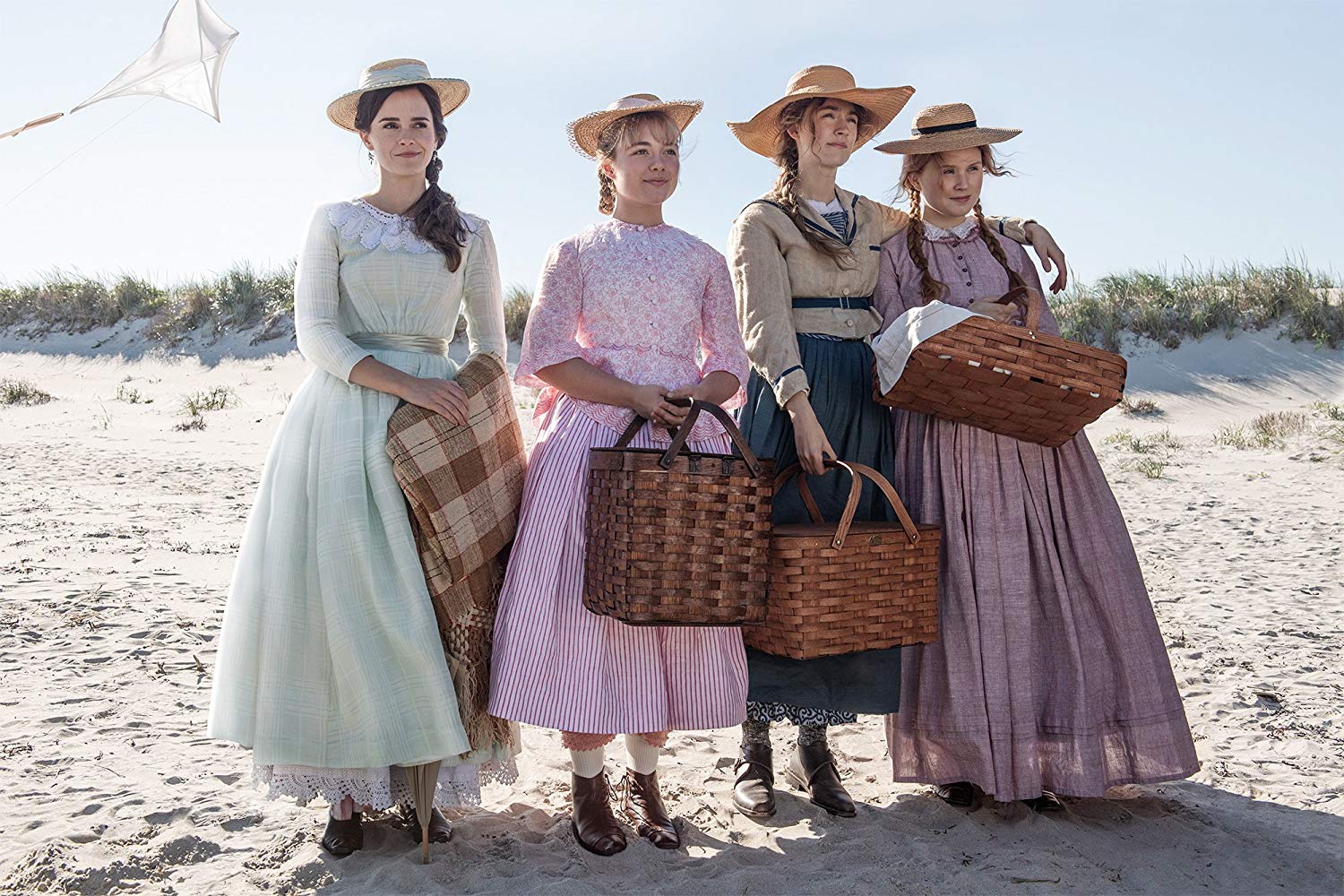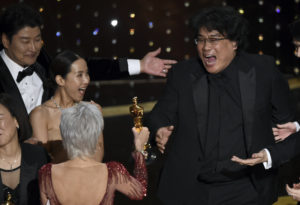‘Little Women’ for Millennials
How is it that a story written 150 years ago manages to speak to the many moments at which it’s been reimagined for moviegoers? From left: Emma Watson, Saoirse Ronan, Florence Pugh and Eliza Scanlen in "Little Women." (Sony Pictures)
From left: Emma Watson, Saoirse Ronan, Florence Pugh and Eliza Scanlen in "Little Women." (Sony Pictures)
Whether literary adaptation or historical drama, a period film reveals as much about the era in which it is made as it does the era in which it is set. Case in point: Greta Gerwig’s “Little Women,” the fourth screen version made since 1933 of the Louisa May Alcott novel about the four March sisters. One reason it is remade so often is that, more than a century before Alison Bechdel proposed her “Bechdel test” to confront gender inequity in entertainment, “Little Women” had already gotten it right. It’s fun to see how those who adapt Alcott inevitably project their zeitgeist onto hers.
Few narratives honor the very different choices very different women make with their lives. That, I think, is one reason Alcott’s story is ageless. There’s an additional bonus: Watch the iterations of “Little Women” chronologically and you see radically different interpretations. The earlier versions are about America at war and at peace. The later ones are tuned into how women negotiate a world tilted against them.
Seen from a present-day perspective, the 1933 version of “Little Women” starring Katharine Hepburn as aspiring writer Jo reflects both the Depression era in which it was made and the Civil War era in which it is set. Director George Cukor frames the story as one in which the March family falls from prosperity to the striving end of the working class. Brought together by hard times, they embody New Deal ideas of sacrifice and sharing the wealth. The March family helps their immigrant neighbors, the Hummels; the wealthy Laurences help out the less fortunate Marches.
Released in 1949 and starring June Allyson as Jo, Mervyn LeRoy’s “Little Women” underlines the similarities between the periods following the Civil War and World War II, when women are eased out of the workplace and back into the domestic sphere. It seems less 1865 than 1945 when Laurie Laurence (Peter Lawford) patronizingly proposes to Jo, noting that if she accepts him she won’t have to write anymore. He has failed to notice that Jo’s identity is as a writer.
Gillian Armstrong’s 1994 film may be the canonical big-screen version of “Little Women.” Released shortly after the 1980s-’90s years that feminist critiques dubbed “post-feminist,” it revels in a multitude of feminisms. Every scene is alive with active women involved both in their duties as breadwinners and their avocations as artists. They are caregivers, rolling bandages at hospitals and rolling out dough in the kitchen. And they are sustained by creative work, whether it’s Jo (Winona Ryder) at her desk writing, Amy (Kirsten Dunst) at her sketchbook drawing, or Beth (Claire Danes) at the piano.
Where their filmmaking predecessors tend to frame Jo as unconventional and her sisters traditional, Armstrong and screenwriter Robin Swicord, along with the titular little women and their mother, Marmee, see a spectrum of women who make individual choices and support each other in them.
Gerwig’s adaptation—she both wrote the screenplay and directed—is more pragmatic, dramatizing many of the same vignettes but framing the story differently. For the writer/director, it’s about how the daughters of an improvident father (played by Bob Odenkirk) and a resourceful mother (a splendid Laura Dern) make decisions about marriage and about art. Do they do it for love or for money? One of the sisters, Meg (Emma Watson) chooses love; two others, Jo (Saiorse Ronan) and Amy (Florence Pugh, also splendid), find ways to balance both. In order to find that equilibrium, Jo must make compromises to her art, while Amy consider compromises to her heart.
The film opens in the middle of Alcott’s story, with the adult Jo bracing herself to walk into the office of “The Weekly Volcano,” the journal to which she wants to submit her fiction. Mr. Dashwood, its proprietor (Tracy Letts), gives her a ironclad rule: By story’s end, the heroine must be “married or dead.” While Alcott herself never wed (she wasn’t so inclined, and anyway, she was too busy supporting her sisters and their kin), her alter ego, Jo, will make sure that each March sister ends as Mr. Dashwood demands. (Those who know how movie studios run today can also imagine Mr. Dashwood’s counterpart saying something like this to Gerwig.)
Gerwig proceeds from the establishing scene to ping-ponging flashbacks and flash-forwards. This has the advantage of accelerating the pace of an episodic narrative but the disadvantage of causing character development interruptus. The pleasure of coming-of-age stories is in watching characters evolve. By scrambling the chronology, Gerwig discloses effects before showing their causes. (Many in the audience I saw it with kept asking out loud, “Have we gone ahead or back in time?”)
Filmmaker Jean-Luc Godard famously observed that a movie needs a beginning, middle and an end, but not necessarily in that order. In this case, discontinuous storytelling is to the detriment of the performers—particularly to Watson, whose Meg is superfluous in this telling, and to Ronan, an actress of unshakable confidence, whose rhythms are shaky here. As Laurie, Timothee Chalamet, who plays Laurie, seems downright anachronistic. He’s petulant when he should be ardent and giggly when he should be buoyant.
Happily, Laura Dern as Marmee and Florence Pugh as Amy enlarge every scene they are in and emerge as the critical characters. Amy, the vain, calculating and materialistic youngest, is the least likeable in the novel and in most of the movies (Elizabeth Taylor played her in the 1949 version). Gerwig and Pugh interpret Amy as one who belatedly emerges from Jo’s long shadow.
Amy’s the one her father’s rich aunt dotes on, the one Aunt March (Meryl Streep) instructs to marry well so she can support her family. Much to Amy’s own surprise, she’s not a gold digger. She doesn’t marry the man her aunt chooses; she chooses the one she loves. In loving, she grows a conscience, heart and generosity conspicuously absent in her youth.
The parts of Gerwig’s film I appreciated most were those of its candidness about the economic choices a woman makes. Some of them are in Alcott’s novel—as they are in the novels of Jane Austen and Willa Cather. Others—like a very droll exchange between Dashwood and Jo about her percentage of book profits, are Gerwig’s projections of our zeitgeist onto Alcott’s.
“Little Women” may have been written more than 150 years ago, yet it is still so pertinent today that every movie version has things to teach new generations of fans. Of how many other novels, or movies, can we say the same?
Your support is crucial...As we navigate an uncertain 2025, with a new administration questioning press freedoms, the risks are clear: our ability to report freely is under threat.
Your tax-deductible donation enables us to dig deeper, delivering fearless investigative reporting and analysis that exposes the reality beneath the headlines — without compromise.
Now is the time to take action. Stand with our courageous journalists. Donate today to protect a free press, uphold democracy and uncover the stories that need to be told.






You need to be a supporter to comment.
There are currently no responses to this article.
Be the first to respond.